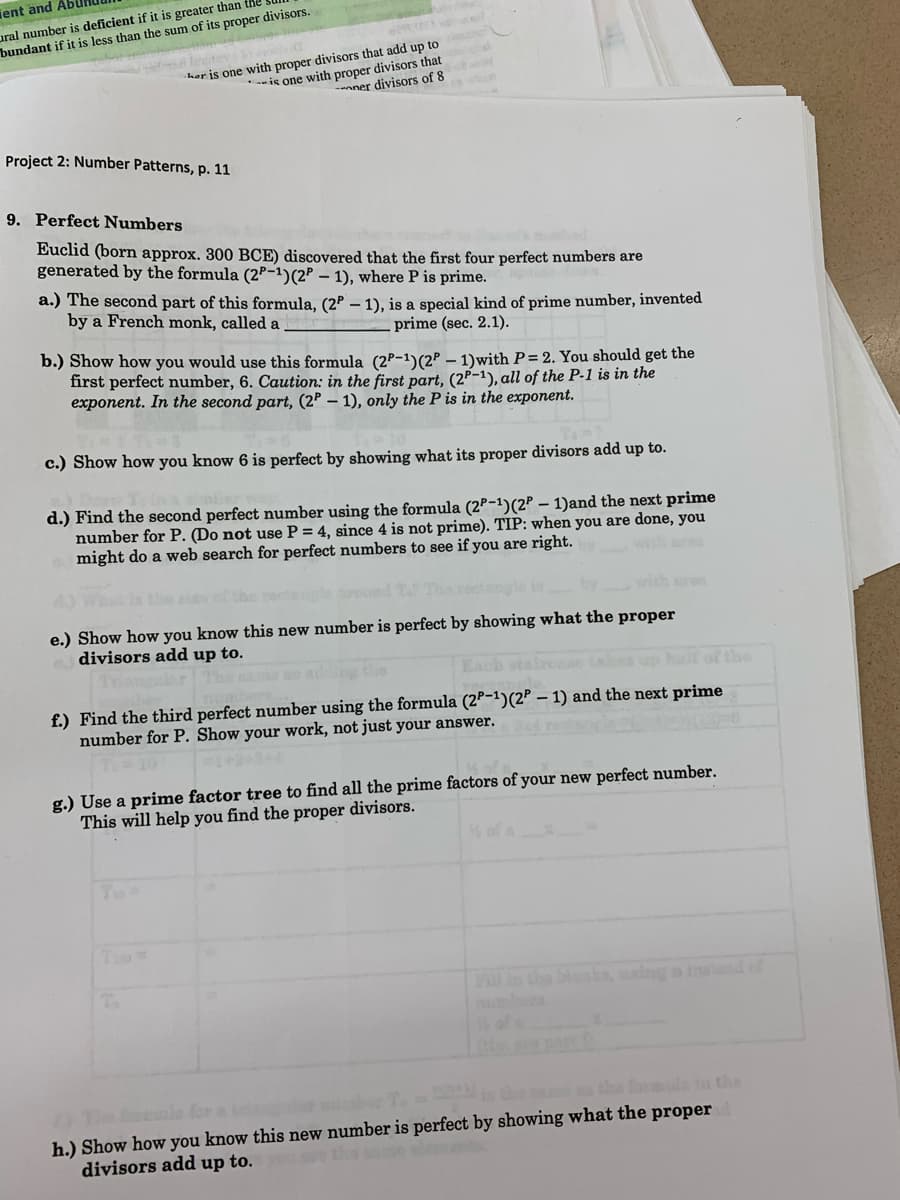bers Euclid (born approx. 300 BCE) discovered that the first four perfect numbers are generated by the formula (2P-1)(2P – 1), where P is prime. a.) The second part of this formula, (2P – 1), is a special kind of prime number, invented by a French monk, called a prime (sec. 2.1). b.) Show how you would use this formula (2P-1)(2P – 1)with P= 2. You should get the first perfect number, 6. Caution: in the first part, (2P-1), all of the P-1 is in the exponent. In the second part, (2P – 1), only the P is in the exponent. c.) Show how you know 6 is perfect by showing what its proper divisors add up to.
bers Euclid (born approx. 300 BCE) discovered that the first four perfect numbers are generated by the formula (2P-1)(2P – 1), where P is prime. a.) The second part of this formula, (2P – 1), is a special kind of prime number, invented by a French monk, called a prime (sec. 2.1). b.) Show how you would use this formula (2P-1)(2P – 1)with P= 2. You should get the first perfect number, 6. Caution: in the first part, (2P-1), all of the P-1 is in the exponent. In the second part, (2P – 1), only the P is in the exponent. c.) Show how you know 6 is perfect by showing what its proper divisors add up to.
Algebra: Structure And Method, Book 1
(REV)00th Edition
ISBN:9780395977224
Author:Richard G. Brown, Mary P. Dolciani, Robert H. Sorgenfrey, William L. Cole
Publisher:Richard G. Brown, Mary P. Dolciani, Robert H. Sorgenfrey, William L. Cole
Chapter11: Rational And Irrational Numbers
Section11.8: Adding And Subtracting Radicals
Problem 5E
Related questions
Question
100%

Transcribed Image Text:ient and Abl
ural number is deficient if it is greater than
bundant if it is less than the sum of its proper divisors.
lente
her is one with proper divisors that add up to
--is one with proper divisors that
nner divisors of 8
Project 2: Number Patterns, p. 11
9. Perfect Numbers
Euclid (born approx. 300 BCE) discovered that the first four perfect numbers are
generated by the formula (2P-1)(2P – 1), where P is prime.
a.) The second part of this formula, (2P – 1), is a special kind of prime number, invented
by a French monk, called a
prime (sec. 2.1).
b.) Show how you would use this formula (2P-1)(2P – 1)with P= 2. You should get the
first perfect number, 6. Caution: in the first part, (2P-1), all of the P-1 is in the
exponent. In the second part, (2P – 1), only the P is in the exponent.
c.) Show how you know 6 is perfect by showing what its proper divisors add up to.
d.) Find the second perfect number using the formula (2P-1)(2P – 1)and the next prime
number for P. (Do not use P = 4, since 4 is not prime). TIP: when you are done, you
might do a web search for perfect numbers to see if you are right.
wtar
with sre
e.) Show how you know this new number is perfect by showing what the proper
divisors add up to.
the
f.) Find the third perfect number using the formula (2P-1)(2P – 1) and the next prime
number for P. Show your work, not just your answer.
g.) Use a prime factor tree to find all the prime factors of your new perfect number.
This will help you find the proper divisors.
FOlin Che blonks, aalng a inatnd of
the the forule in the
The la fon
h.) Show how you know this new number is perfect by showing what the proper
divisors add up to.
thesome elants
Expert Solution
This question has been solved!
Explore an expertly crafted, step-by-step solution for a thorough understanding of key concepts.
Step by step
Solved in 4 steps with 3 images

Recommended textbooks for you

Algebra: Structure And Method, Book 1
Algebra
ISBN:
9780395977224
Author:
Richard G. Brown, Mary P. Dolciani, Robert H. Sorgenfrey, William L. Cole
Publisher:
McDougal Littell

Algebra: Structure And Method, Book 1
Algebra
ISBN:
9780395977224
Author:
Richard G. Brown, Mary P. Dolciani, Robert H. Sorgenfrey, William L. Cole
Publisher:
McDougal Littell